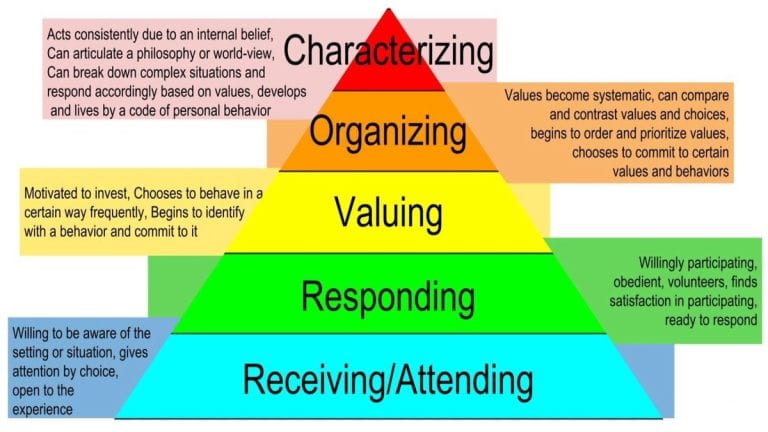Mark GAN
Centre for Development of Teaching & Learning (CDTL)
This Special Column considers how we can apply Bloom’s taxonomy of affective domains to formulate learning objectives/outcomes which draws our attention on students’ values, feelings, motivation and appreciations, besides cognitive outcomes.

Gan, M. J. S. (2023, January 31). Moving beyond cognitive learning outcomes. Teaching Connections. https://blog.nus.edu.sg/teachingconnections/2023/01/30/moving-beyond-cognitive-learning-outcomes/
While we transition to the ‘new normal’ and grapple with redefining what higher education means after the pandemic, it is needless to remind ourselves that student engagement and wellbeing will feature greatly, if not centrally, in our teaching approaches and practices. We no longer could treat effective learning (for that matter, teaching as well) as a solitary activity, done in isolation and without support from peers, teachers, and other stakeholders. A quick browse at the emerging literature about university students’ coping mechanisms during the pandemic attest to the adverse effects of isolation, loneliness, and disengagement (e.g. Tam et al., 2021).
To draw our attention to students’ affective engagement/wellbeing, I would like to propose a revisit of Bloom’s taxonomy of affective domain (Krathwohl, 2002) as a means to help formulate learning objectives or outcomes which serve to guide, communicate, and assess the impact of our teaching beyond the cognitive domain. While we are familiar with Bloom’s taxonomy of cognitive outcomes (i.e., what the teacher wants the student to be able to know or do something after the lecture or tutorial in terms of remembering, understanding, applying, analysing, evaluating, and creating), less frequently considered is the affective domain—feelings, values, attitudes, and appreciations. Figure 1, taken from Lynn Lease’s post on her blog Teaching, Learning, & Everything In Between, provides a clear overview of the levels of affective outcomes (Lease, 2018).

Figure 1. Overview of the levels of affective outcomes in Krathwohl and Bloom’s affective taxonomy (Lease, 2018).
Meanwhile, Table 1 presents an example of affective learning outcomes related to developing an engineer’s professional attitude (taken from Lynch et al., 2009).
Table 1
Example of affective learning outcomes related to developing the professional attitudes for engineers (Lynch et al., 2009)
|
1 |
Receiving: |
Describe attitudes conducive to the effective practice of engineering; |
|
2 |
Responding: |
Identify situations where attitudes are or will be important to engineering success; Identify the attitudes involved in real situations; |
|
3 |
Valuing: |
Demonstrate proper attitudes in engineering performance and interpretation of tasks; commit to them; |
|
4 |
Organising/ Conceptualising: |
Lead by example in the application of proper attitude in complex situations and with other professionals; Inspire professional attitude in colleagues and clients; and |
|
5 |
Characterising: |
Develop and implement a consistent expectation of proper professional attitude within the engineering unit and extending to other units with whom cooperation is necessary. |
The use of affective domain taxonomy in learning outcomes should not only be seen as promoting ‘soft skills’; research has continued to show that helping students to regulate academic emotions and feelings is beneficial to cognitive growth, self-confidence, and overall achievement (e.g. Pekrun, 2007).
References
Krathwohl, D. R. (2002). A revision of Bloom’s Taxonomy: An overview. Theory Into Practice, 41(4), 212–218. https://doi.org/10.1207/s15430421tip4104_2
Lease, L. (2018, August 23). Krathwohl and Bloom’s affective taxonomy. Teaching, Learning, & Everything in Between. https://lynnleasephd.com/2018/08/23/krathwohl-and-blooms-affective-taxonomy/
Lynch, D. R., Russell, J. S., Evans, J. C., & Sutterer, K. G. (2009). Beyond the cognitive: The affective domain, values, and the achievement of the vision. Journal of professional issues in engineering education and practice, 135(1), 47-56. https://doi.org/10.1061/(ASCE)1052-3928(2009)135:1(47)
Pekrun, R. (2007). Emotions in students’ scholastic development. In R. P. Perry & J. C. Smarts (Eds.), The scholarship of teaching and learning in higher education: An evidence-based perspective (pp. 553–610). Springer.
Tam, W., Poon, S. N., Mahendran, R., Kua, E. H., Wu, X. V. (2021). Impacts of COVID-19 and partial lockdown on family functioning, intergenerational communication and associated psychosocial factors among young adults in Singapore. BMC Psychiatry, 21, 595. https://doi.org/10.1186/s12888-021-03599-z
 |
Mark GAN is an Associate Director of the Centre for Development of Teaching and Learning (CDTL) in NUS. He has been involved in a wide variety of higher educational initiatives and programmes to enhance professional development of staff, such as courses for developing a Teaching Portfolio and writing of teaching inquiry grants. His research interests include feedback and assessment, and the impact of academic development work on teaching and learning. Mark has a PhD in Education from the University of Auckland, supervised by Professor John Hattie. Mark can be reached at mark.gan@nus.edu.sg. |

